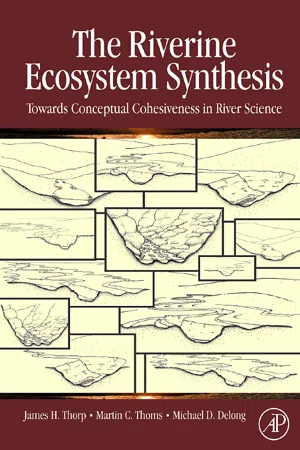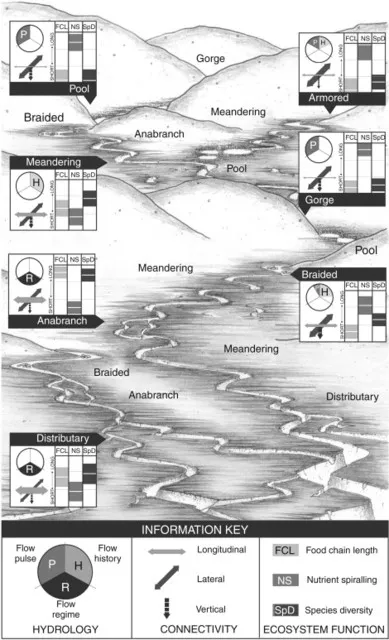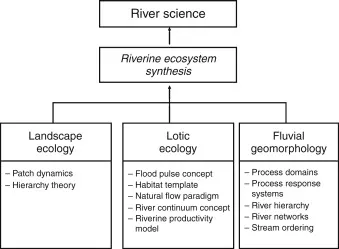
eBook - ePub
The Riverine Ecosystem Synthesis
Toward Conceptual Cohesiveness in River Science
- 232 pages
- English
- ePUB (mobile friendly)
- Available on iOS & Android
eBook - ePub
The Riverine Ecosystem Synthesis
Toward Conceptual Cohesiveness in River Science
About this book
This book presents the most comprehensive model yet for describing the structure and functioning of running freshwater ecosystems. Riverine Ecosystems Synthesis (RES) is a result of combining several theories published in recent decades, dealing with aquatic and terrestrial systems. New analyses are fused with a variety of new perspectives on how river network ecosystems are structured and function, and how they change along longitudinal, lateral, and temporal dimensions. Among these novel perspectives is a dramatically new view of the role of hydrogeomorphic forces in forming functional process zones from headwaters to the mouths of great rivers.
Designed as a useful tool for aquatic scientists worldwide whether they work on small streams or great rivers and in forested or semi-arid regions, this book will provide a means for scientists to understand the fundamental and applied aspects of rivers in general and includes a practical guide and protocols for analyzing individual rivers. Specific examples of rivers in at least four continents (Africa, Australia, Europe and North America) serve to illustrate the power and utility of the RES concept.
- Develops the classic, seminal article in River Research and Applications, "A Model of Biocomplexity in River Networks Across Space and Time" which introduced the RES concept for the first time
- A guide to the practical analysis of individual rivers, extending its use from pristine ecosystems to modern, human-modified rivers
- An essential aid both to the study fundamental and applied aspects of rivers, such as rehabilitation, management, monitoring, assessment, and flow manipulation of networks
Frequently asked questions
Yes, you can cancel anytime from the Subscription tab in your account settings on the Perlego website. Your subscription will stay active until the end of your current billing period. Learn how to cancel your subscription.
At the moment all of our mobile-responsive ePub books are available to download via the app. Most of our PDFs are also available to download and we're working on making the final remaining ones downloadable now. Learn more here.
Perlego offers two plans: Essential and Complete
- Essential is ideal for learners and professionals who enjoy exploring a wide range of subjects. Access the Essential Library with 800,000+ trusted titles and best-sellers across business, personal growth, and the humanities. Includes unlimited reading time and Standard Read Aloud voice.
- Complete: Perfect for advanced learners and researchers needing full, unrestricted access. Unlock 1.4M+ books across hundreds of subjects, including academic and specialized titles. The Complete Plan also includes advanced features like Premium Read Aloud and Research Assistant.
We are an online textbook subscription service, where you can get access to an entire online library for less than the price of a single book per month. With over 1 million books across 1000+ topics, we’ve got you covered! Learn more here.
Look out for the read-aloud symbol on your next book to see if you can listen to it. The read-aloud tool reads text aloud for you, highlighting the text as it is being read. You can pause it, speed it up and slow it down. Learn more here.
Yes! You can use the Perlego app on both iOS or Android devices to read anytime, anywhere — even offline. Perfect for commutes or when you’re on the go.
Please note we cannot support devices running on iOS 13 and Android 7 or earlier. Learn more about using the app.
Please note we cannot support devices running on iOS 13 and Android 7 or earlier. Learn more about using the app.
Yes, you can access The Riverine Ecosystem Synthesis by James H. Thorp,Martin C. Thoms,Michael D. Delong in PDF and/or ePUB format, as well as other popular books in Biological Sciences & Ecology. We have over one million books available in our catalogue for you to explore.
Information
Chapter 1. Introduction to the Riverine Ecosystem Synthesis
Background and Scope
Conceptual Cohesiveness
Researchers in many scientific disciplines have long sought to integrate their field’s diverse theories and models into a small set of core principles, but with only minor successes and much frustration. Within aquatic ecology, Stuart Fisher (1997) wrote a candid and rather damning account of the contributions of the habitat-defined field of stream ecology to advancements in the discipline of general ecology. His conclusions were based in part on a conviction that concepts in stream ecology were either too habitat-specific or lacked explicit links to general ecological theory. Although the drive within aquatic ecology to develop this conceptual cohesiveness is not comparable in fervor to physicists seeking a unified field theory, attainment of this scientific goal would still be monumental for stream ecology and the contributions of our discipline to ecology in general would be that much greater. However, even if a broad conceptual theory of riverine ecology was judged insignificant by scientists from the perspectives of their own terrestrial and marine habitats, that cohesive theory could substantially advance our own aquatic discipline – especially if it had both theoretical and practical applications – and thus should be a meritorious goal in its own right. Indeed, we maintain that a concurrent goal of all conceptually oriented riverine scientists should be to make their models useful to the large group of environmental scientists and managers who have the difficult task of extracting bits of fundamental theory and applying them to real-world situations. We suspect in most cases that riverine theories are either dismissed as impractical outside of academia or misapplied because of a lack of usable approaches embedded in the theory – the blame for which could be equally laid on the doorsteps of the theorist and the applied scientist.
As in evolutionary biology (Mayr, 1970), a viable cohesive theory is unlikely to be a single factor model and would probably include a balance of conflicting forces. An effective synthesis could draw upon special case theories (e.g., the Flood Pulse Concept (FPC) in lowland floodplain rivers; Junk et al., 1989) but should be more than a compilation of such models. We might be better served in seeking this goal by actively discarding nonviable theories, but the easier (more collegial?) way is usually to let time accomplish that chore. One problem with this approach is that our general textbooks tend to retain old theories long past their prime.
Given that riverine ecosystems are rather mercurial in time and space compared to the average type of global ecosystem, a broad conceptual theory of riverine ecology might contribute more to general ecology by emphasizing this environmental variability. In an analogous fashion, Fisher (1997) suggested that an exploration of ideas about stream shape and its functional consequences could be an opportune area for contributions of stream ecology to general ecological theory.
Our contribution to this quest for a general riverine theory is the heuristic Riverine Ecosystem Synthesis (RES; Thorp et al., 2006). As summarized in the current chapter, the RES is an integrated model derived from aspects of other aquatic and terrestrial models proposed from 1980 to 2007, combined with our perspectives on functional process zones (FPZs) and other aspects of riverine biocomplexity. The RES pertains to the entire riverine landscape, which includes both the floodscape and the riverscape. This contrasts with many lotic models whose primary emphasis or support focuses on main channel systems within headwaters. This synthesis, which incorporates the ecosystem consequences of spatiotemporal variability across mostly longitudinal and lateral dimensions, has three broad components:
- A fundamental, physical model describing the hierarchical patchy arrangement of riverine landscapes within longitudinal and lateral dimensions (Fig. 1.1) based primarily on hydrogeomorphology and emphasizing a new geomorphic division (an FPZ) between the reach and the valley scale (see Fig. 4.3);
Figure 1.1. A conceptual riverine landscape is shown depicting various functional process zones (FPZs) and their possible arrangement in the longitudinal dimension. Not all FPZs and their possible spatial arrangements are shown. Note that FPZs are repeatable and only partially predictable in location. Information contained in the boxes next to each FPZ depicts the hydrologic and ecological conditions predicted for that FPZ. Symbols are explained in the information key. Hydrologic scales are flow regime, flow history, and flow regime as defined by Thoms and Parsons (2002), with the scale of greatest importance indicated for a given FPZ. The ecological measures [food chain length (FCL), nutrient spiraling, and species diversity] are scaled from long to short, with this translated as low to high for species diversity. The light bar within each box is the expected median, with the shading estimating the range of conditions. Size of each arrow reflects the magnitude of vertical, lateral, and longitudinal connectivity (See color plate 1).

- Ecological implications of the physical model in terms of an expandable set of 17 general to specific (testable) hypotheses, or model tenets, on biocomplexity, which is applicable in some form to both pristine and altered riverine landscapes;
- A framework for studying, managing, and rehabilitating riverine landscapes through the use of the hierarchical physical model and aquatic applications of the terrestrially derived hierarchical patch dynamics (HPD) model (Wu and Loucks, 1975).
Our goal is to provide a framework for the development of a cohesive theory of riverine ecosystems over time rather than to produce a finished product between the covers of this book. In this task, we draw upon three primary components of river science that contribute to the study of riverine landscapes: lotic ecology, landscape ecology, and fluvial geomorphology (Fig. 1.2).
Figure 1.2. Contribution of the Riverine Ecosystem Synthesis towards conceptual cohesiveness in the field of river science. The RES specifically brings together concepts and paradigms from the disciplines of landscape ecology, lotic ecology, and fluvial geomorphology.

Organization of this Book
The original 2006 publication of the RES in the journal River Research and Applications included an historical perspective, a description of the hydrogeomorphic model, application of the HPD model to riverine ecosystems, and development of 14 RES hypotheses (tenets). Our discussion of the RES in this book is divided between two sections (fundamental and applied) and eight chapters. We begin in Section 1 with a broad overview of the RES (Chapter 1), place the RES in a historical context (Chapter 2), and describe hierarchy theory, patch dynamics, and their combination (HPD) in riverine ecosystems (Chapter 3). From there, we explain the importance of a hydrogeomorphic approach for analyzing riverine systems from a theoretical perspective (Chapter 4) and then describe actual methods for defining FPZs for rivers in multiple continents using top-down (e.g., remote sensing) and bottom-up approaches (Chapter 5). This fundamental section ends with an examination of the ecological implications of our hierarchical, hydrogeomorphic model in the form of 17 biocomplexity tenets (Chapter 6), which cover a range of topics from species distributions to landscape processes. Given that pristine rivers in economically developed and developing countries are now almost always part of our lost environmental heritage, we included Chapter 7 in our more applied section to explore both effects of river regulation on model tenets and how the model tenets could be used to manage and rehabilitate riverine landscapes. These perspectives are meant to aid scientists in examining both fundamental and applied aspects of riverine landscapes. Chapter 8 is designed to serve as a roadmap for application of the RES to environmental problems dealing with monitoring, assessment, management, conservation, and rehabilitation of riverine ecosystems.
Basic concepts in the Riverine Ecosystem Synthesis
Many prominent riverine theories, such as the River Continuum Concept (RCC; Vannote et al., 1980) and the FPC (Junk et al., 1989), have included diverse ecological and theoretical elements, but later analyses or applications of these concepts have tended to emphasize only one or two elements – unfortunately, either ignoring the remainder or lumping the entire package (concept) into agree or disagree categories, resulting in a less sophisticated and often polarized discussions in the scientific literature. For the RCC, the idea of a longitudinal continuum of species and functional feeding groups based on stream size/order was the focus of most comments in the literature, and aspects of energetics were largely ignored. In the case of the FPC, the rapidly acknowledged importance of the physical flood pulse overwhelmed any serious discussion of the validity of the potentially important trophic model.
Although our abilities to prognosticate are not especially acute, we predict that much of the response to the RES will focus on its physical model (see Fig. 1.1). This is primarily because the implications of adopting this physical perspective on rivers could be far-reaching and secondarily because the HPD component of the RES, while still useful and potentially important, is more complex and somewhat onerous to implement in real-world situations. We hope that individual biocomplexity tenets of the RES will also spur various research projects, but these hypotheses are in themselves probably not bases for major shifts in stream ecology. However, some tenets could be used as benchmarks to test successes or failures in protecting, managing, and rehabilitating riverine ecosystems.
Hydrogeomorphic Patches and Functional Process Zones
Two seemingly simple, but important principles upon which we have based the RES are that riverine ecosystems possess a four-dimensional nature (Ward, 1989) and that rivers are more than a single thread passing through a terrestrial landscape (cf., Ward and Tockner, 2001). The longitudinal and lateral (primarily riparian inputs) nature of rivers was emphasized in the RCC, but Ward (1989) focused attention on vertical (e.g., hyporheic) and temporal dimensions also. The lateral dimension and temporal variability of rivers formed the core of the FPC, and the temporal dimension was emphasized by the natural flow regime paradigm (Poff et al., 1997). From a longitudinal perspective, most riverine ecologists over the last century have viewed rivers as being either composed of fixed zones (for 80% of the twentieth century) or laid out as a predictable cline, or continuum. More recently, a few voices in the wilderness (e.g., Montgomery, 1999; Rice et al., 2001; Poole, 2002; Benda et al., 2004; Thoms, 2006; Thorp et al., 2006) have begun viewing rivers as discontinua rather than as predominately ecological clines.
In contrast to a common view of rivers as continuous, longitudinal gradients in physical conditions, the RES portrays rivers as downstream arrays of hierarchically scaled, hydrogeomorphic patches formed by various factors, principally including catchment and valley geomorphology, hydrologic patterns, riparian conditions, and climate. These patches extend longitudinally, laterally, and vertically, and they may vary temporally from subseasonal to geological time periods. The nature of these hydrogeomorphic patches can differ substantially among and within patch types in spatiotemporal gradients of hydrology and structural complexity. Hydrogeomorphic patches exist at multiple scales, such as drainage basins, valleys, reaches, sets (e.g., a riffle–pool sequence), and units (e.g., a riffle). Missing in this traditional division, however, is a hydrogeomorphic patch intermediate in scale between valleys and reaches. This spatial division has been termed an FPZ (Thoms, 2006). The “functional” portion of the name was designated prior to the development of the RES and primarily reflects the perspectives of fluvial geomorphologists. This may be a bit confusing to aquatic ecologists who tend to think of function in terms of ecological processes, such as nutrient spiraling and net ecosystem metabolism. In the RES use of the term, however, it pertains to the physical functioning of geomorphic and hydrologic forces, which shape sections of a riverine ecosystem and thereby alter ecosystem structure and function. An easy, initial way to think of these patches is to envision hydrologic and geomorphic dif...
Table of contents
- Brief Table of Contents
- Table of Contents
- List of Figures
- List of Tables
- Foreword
- Preface
- Acknowledgments
- Chapter 1. Introduction to the Riverine Ecosystem Synthesis
- Chapter 2. Historical and Recent Perspectives on Riverine Concepts
- Chapter 3. Hierarchical Patch Dynamics in Riverine Landscapes
- Chapter 4. The Spatial Arrangement of River Systems
- Chapter 5. Defining the Hydrogeomorphic Character of a Riverine Ecosystem
- Chapter 6. Ecological Implications of the Riverine Ecosystem Synthesis
- Chapter 7. Ecogeomorphology of Altered Riverine Landscapes
- Chapter 8. Practical Applications of the Riverine Ecosystem Synthesis in Management and Conservation Settings
- Appendix Concluding Remarks
- Bibliography
- Appendix Colour Plates